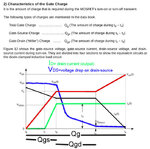Artlav
Full Member level 2

Hello.
I'm trying to make a power regulator for a 500W (30A, 15V) peltier module.
Basic idea is to make 10kHz PWM with a 555 timer regulated from a knob POT, and drive a MOSFET with that.
Problem is, i never done something like that before, and while it seems to work ok, there are several suspicious things with it.
So, i'd like to know what of it is normal, and how to fix whatever of it that is not.
Here is the schematics:

First - there are spikes at the end of duty cycle (measured at MOSFET drain).
These were severely reduced by adding a capacitor across the power supply.
Curiously, adding it at the PSU side does nothing, while putting it close to the MOSFET does all the difference.
Starting from some capacitance there is no point to increase it any more.
Also, no significant difference between a low-ESR capacitor and a regular electrolyte.
What is this spike, and is it anything to worry about at all?
Without the big capacitor (10V/square): http://orbides.1gb.ru/img/no_cap.jpg
With the capacitor: http://orbides.1gb.ru/img/cap_1.jpg
At ~25% duty cycle, magnified: http://orbides.1gb.ru/img/cap_3.jpg
That spike magnified: http://orbides.1gb.ru/img/sp_mag.jpg
Second, the PWM generator alone produces a nice square wave.
But with the MOSFET connected, there is a mess at the gate.
Is that supposed to happen?
Is it related to the spikes at the drain?
5% duty cycle: http://orbides.1gb.ru/img/gate_5.jpg
50%: http://orbides.1gb.ru/img/gate_50.jpg
Third, the MOSFET have an open resistance of 1.46mΩ.
So, if i got this right, at full power it would produce only 30*30*0.00146 = 1.3W of heat.
I'm not sure how to measure that, but with it running at 5% duty cycle a 5x6cm radiator is getting too hot to touch after a few minutes.
Nothing a fan can't fix, but is that really how much 0.065W is?
I suspect there is something not so trivial going on here - how can i calculate power dissipation of a MOSFET in continuous switching action?
Is the heat dissipation related to the first and second?
I suspect that the strange form at the gate might cause it to spend significant time with higher resistance, causing lots of extra heat, but no idea how to check this.
I'm trying to make a power regulator for a 500W (30A, 15V) peltier module.
Basic idea is to make 10kHz PWM with a 555 timer regulated from a knob POT, and drive a MOSFET with that.
Problem is, i never done something like that before, and while it seems to work ok, there are several suspicious things with it.
So, i'd like to know what of it is normal, and how to fix whatever of it that is not.
Here is the schematics:

First - there are spikes at the end of duty cycle (measured at MOSFET drain).
These were severely reduced by adding a capacitor across the power supply.
Curiously, adding it at the PSU side does nothing, while putting it close to the MOSFET does all the difference.
Starting from some capacitance there is no point to increase it any more.
Also, no significant difference between a low-ESR capacitor and a regular electrolyte.
What is this spike, and is it anything to worry about at all?
Without the big capacitor (10V/square): http://orbides.1gb.ru/img/no_cap.jpg
With the capacitor: http://orbides.1gb.ru/img/cap_1.jpg
At ~25% duty cycle, magnified: http://orbides.1gb.ru/img/cap_3.jpg
That spike magnified: http://orbides.1gb.ru/img/sp_mag.jpg
Second, the PWM generator alone produces a nice square wave.
But with the MOSFET connected, there is a mess at the gate.
Is that supposed to happen?
Is it related to the spikes at the drain?
5% duty cycle: http://orbides.1gb.ru/img/gate_5.jpg
50%: http://orbides.1gb.ru/img/gate_50.jpg
Third, the MOSFET have an open resistance of 1.46mΩ.
So, if i got this right, at full power it would produce only 30*30*0.00146 = 1.3W of heat.
I'm not sure how to measure that, but with it running at 5% duty cycle a 5x6cm radiator is getting too hot to touch after a few minutes.
Nothing a fan can't fix, but is that really how much 0.065W is?
I suspect there is something not so trivial going on here - how can i calculate power dissipation of a MOSFET in continuous switching action?
Is the heat dissipation related to the first and second?
I suspect that the strange form at the gate might cause it to spend significant time with higher resistance, causing lots of extra heat, but no idea how to check this.




